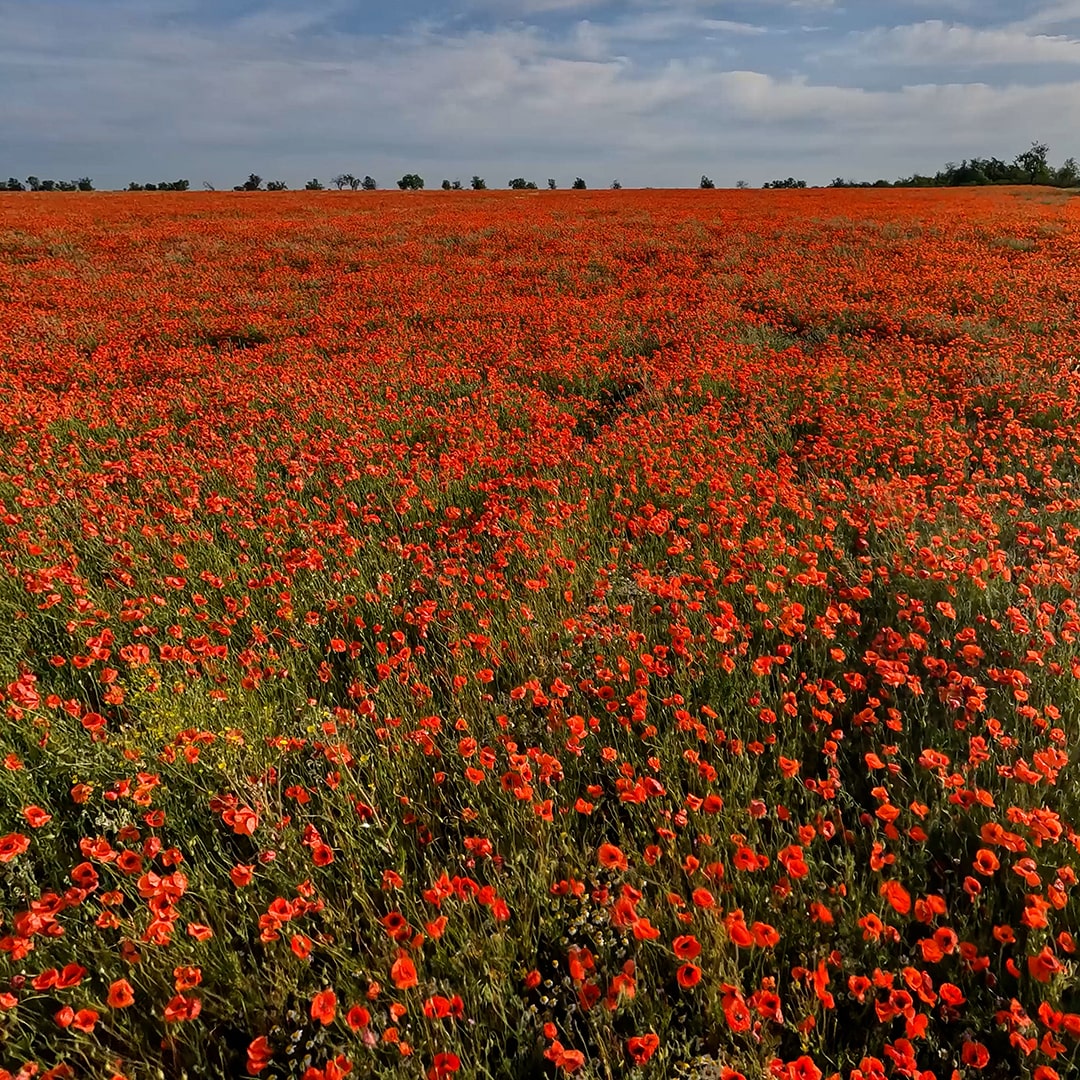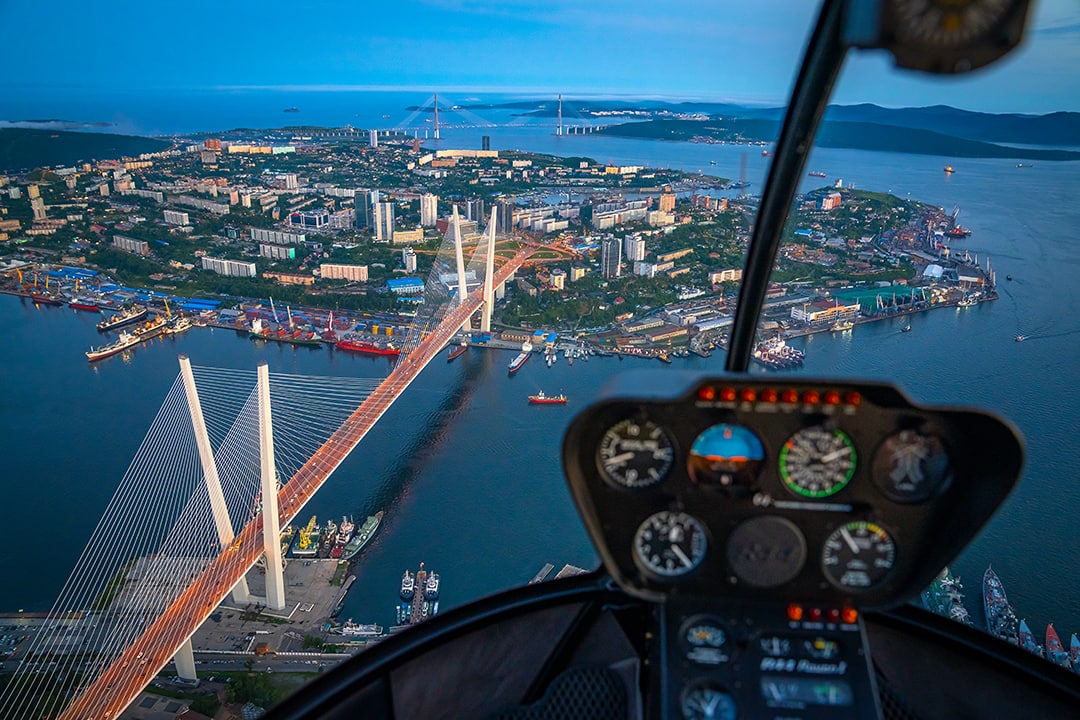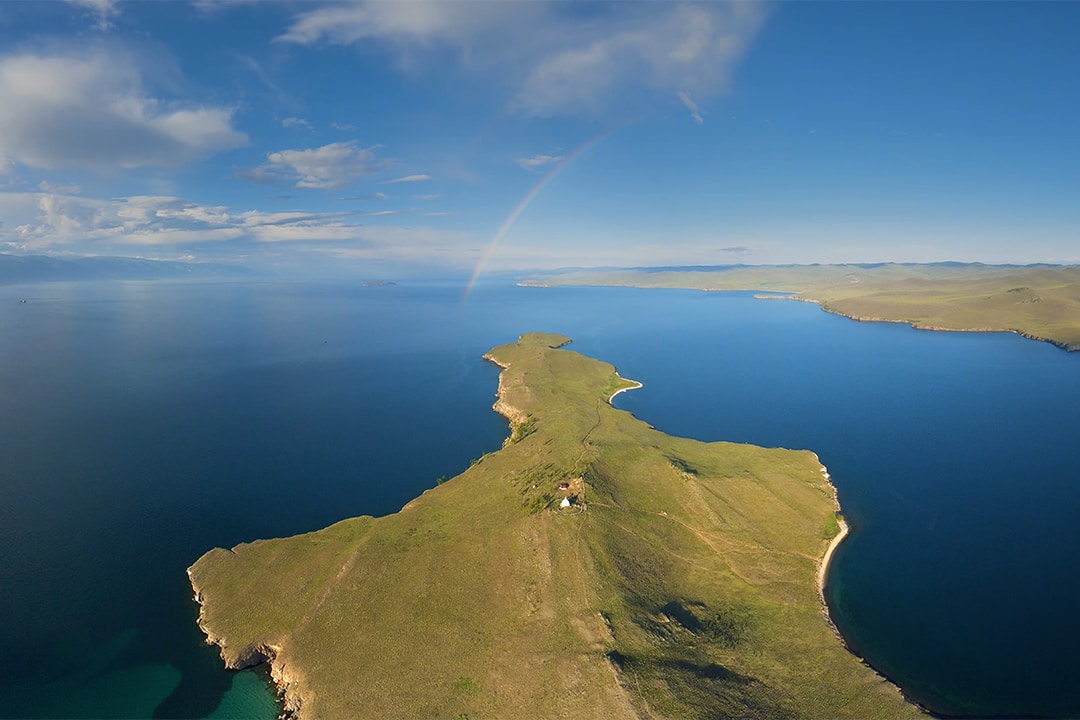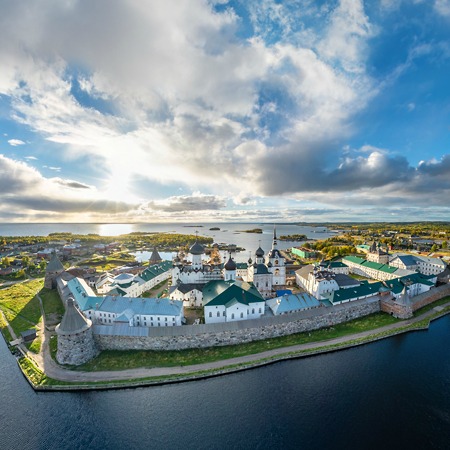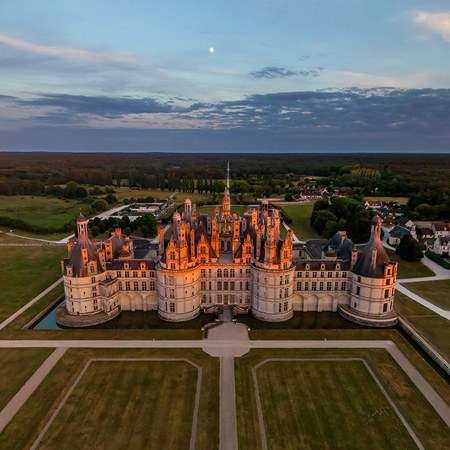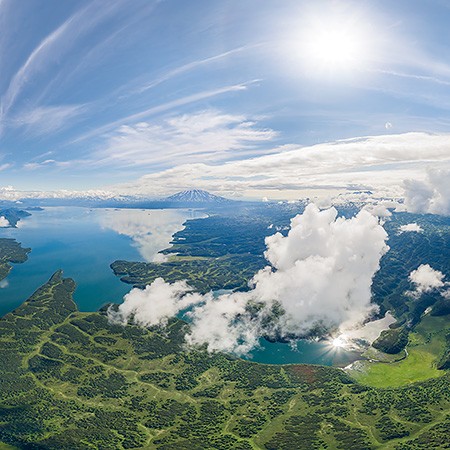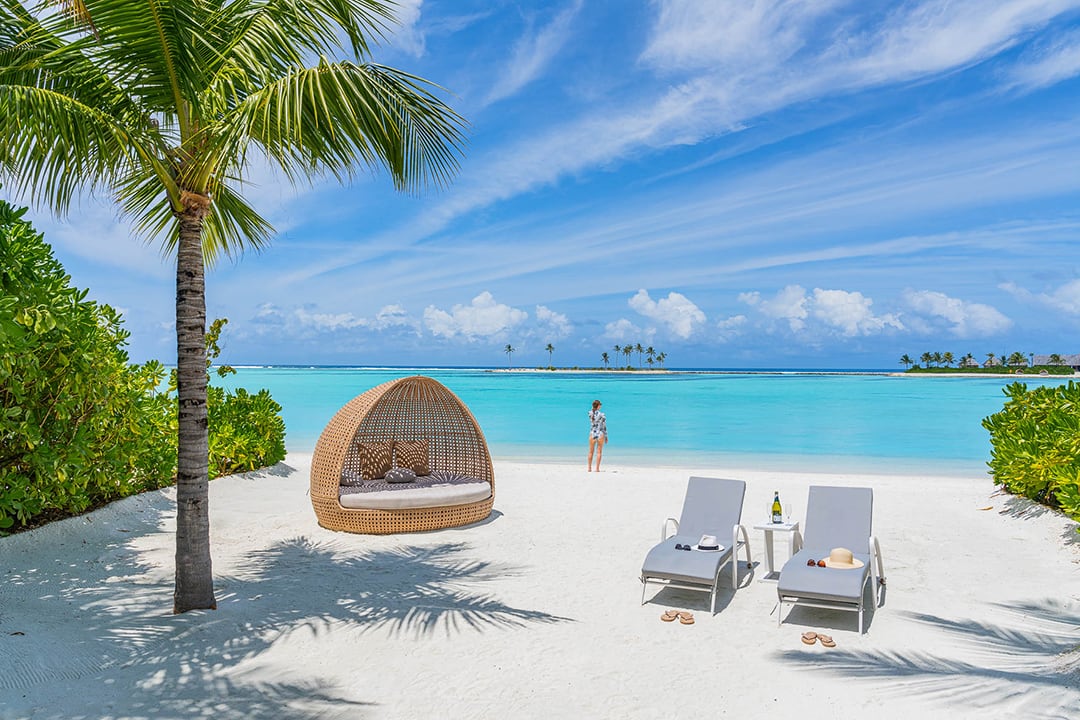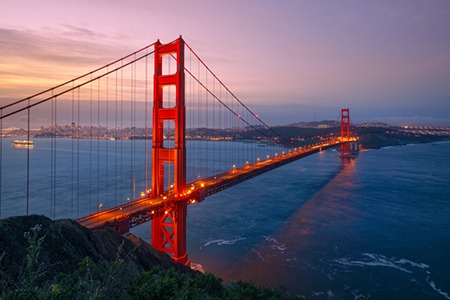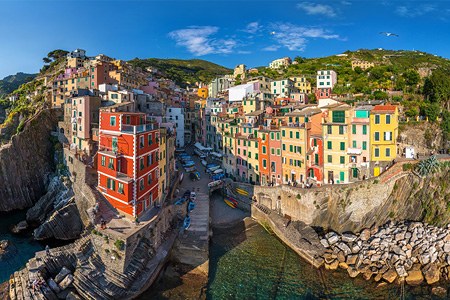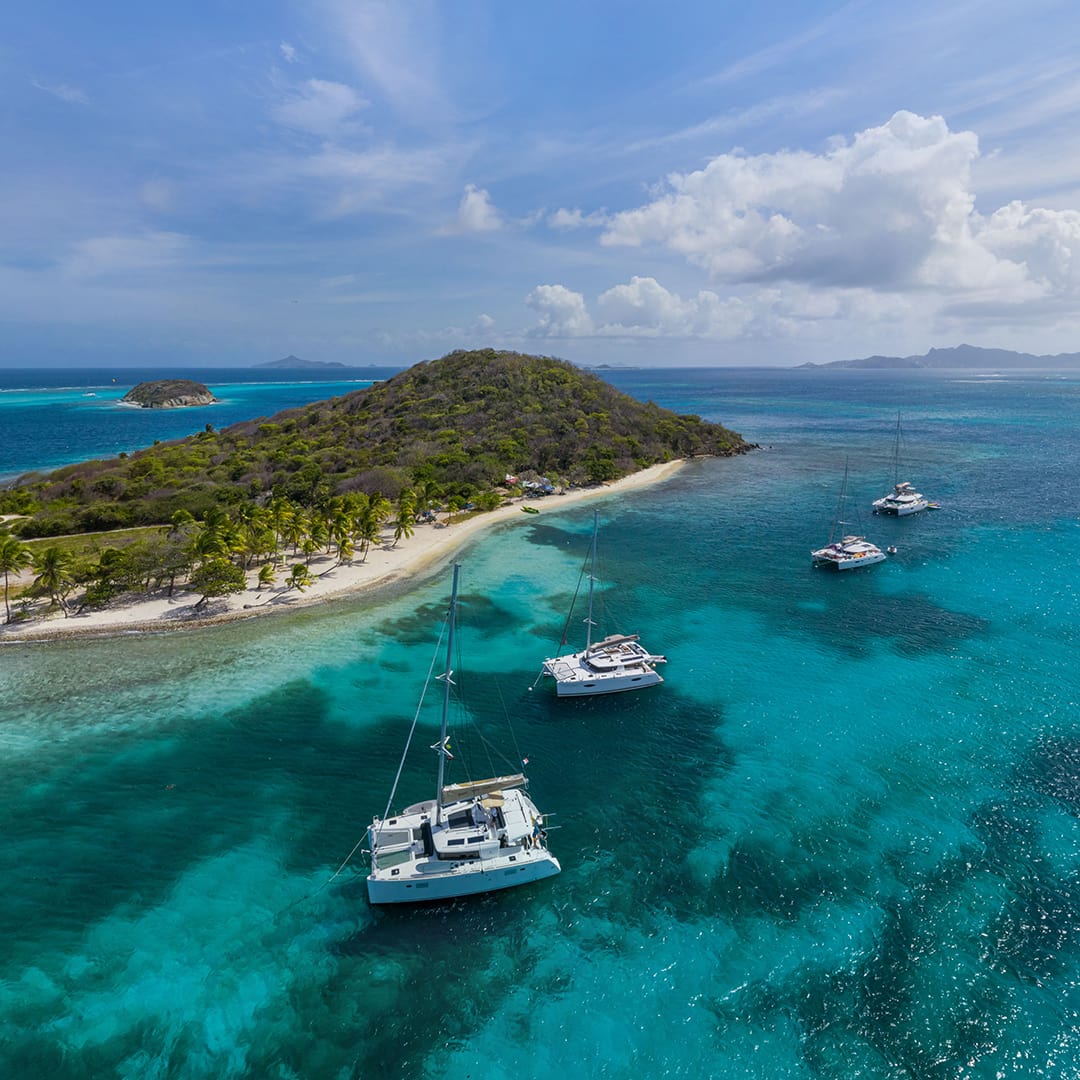Volcano Klyuchevskaya Sopka, Kamchatka, Russia, 2015
A volcano eruption is a unique, natural phenomenon that only a few people get to see in a lifetime. And, it is even more true in the case of the highest volcano in Eurasia.
Back in 2012, the AirPano team had already photographed the Plosky Tolbachik volcano eruption in Kamchatka, so we knew all the technical aspects of the shooting process. But this time we were going to photograph the Klyuchevskaya Sopka eruption at a totally different height — 4800 meters — almost three times higher than the last time. Usually a helicopter is unstable at such an altitude because the air is rarefied, and so an Mi-8 tries not to fly so high: each simple maneuver that is usually performed in seconds, takes several minutes in these conditions.

There is little oxygen in the air which makes it hard to breathe, and the temperature at 5000 meters falls to -50°C (-58°F). All the shooting is done through open hatches, doors, and portholes. Sometimes you even have to lean out into the icy wind.
We were faced with a challenging task but had little idea about the actual difficulties that awaited us ahead. After a long discussion we decided to take a chance, and our camera crew set off for Kamchatka. To get to Kozyrevsk we had to take a nine-hour flight, followed by driving 500 kilometers down a snowy road in a SUV. Even though the volcano was 50 kilometers away we could see it from this point. Occasionally the crater would discharge small ash clouds into the air, but it was very hard to observe the eruption from that distance.

We were set to depart the next day. But in the meantime we got our equipment and warm clothes ready for the trip. It was -25°C (-13°F) on the ground, but the temperature dropped a few degrees every kilometer we went up, which significantly affected our equipment and the crew's efficiency.


And finally the helicopter took off, carrying us to the volcano. Even though we started gaining altitude right away, it was very hard to get to the 5000 meters mark in front of the volcano. At first the helicopter was blown away by the wind, but after a while we managed to navigate to the volcano's main crater. There we saw a fascinating picture: the evening sun illuminating clouds of steam erupting from the crater, along with lava running slowly down the side of the volcano. It was almost unbelievable but the temperature outside was about -50°C (-58°F). After a couple of shots our fingers started to freeze, and the front of the lenses were getting covered with a thin layer of ice, so we had to take pictures almost at random. But then something unprecedented happened: in 15 minutes almost all of our equipment stopped functioning one by one. The first to break down are five professional cameras, and after that our GoPro cameras that were supposed to perform in all kinds of environments. The only thing that saved us was a big stash of equipment that we took with us. It allowed us to get some actual footage out of this trip.

The helicopter hardly maintained the altitude, and despite all of the pilot's efforts we couldn't fly close to the volcano. The moment we saw an enchanting spectacle of light in the sky that made the volcano and erupting clouds of ash turn orange, we faced another problem. Because of the constant struggle to maintain the altitude, our helicopter was running out of fuel much quicker than we anticipated. I wished we had flown off 15 minutes earlier! We begged the pilot to give us more time to take photos, and after calculating the fuel consumption, he agreed to hover near the volcano for a few more minutes. During that time we were able to capture an unimaginably beautiful landscape. After that the helicopter started a rapid descent. We couldn't even imagine that an Mi-8 could fly this way. It was really scary. We tried not to look back as we flew away from the magnificently blazing sunset. We landed on the helipad with the fuel tanks almost empty. Our pilot even joked about "fuel vapor" being the only thing that held us in the air.

Due to the extremely rapid descent, we became partially deaf — our ears became tightly clogged. For a few days after that we had to shout to hear each other. It took two weeks for Stanislav to get rid of his hearing problems completely.

A few magnificent volcano views, an incredible roller coaster adventure on a helicopter, and equipment that suddenly started working again sweetened our first unsuccessful flight a little bit. But, we had never felt so much disappointment from missed opportunities before.

The next day all of us wished for only one thing — to correct the mistakes made during the previous evening. We decided to repeat the flight, changing the departure time so that we could shoot against the sunset illuminating the volcano. Unfortunately, this time our problems began on the ground — during the preflight testing our equipment stopped working. We lost precious 30 minutes soldering disconnected wire to the camera's stabilization system right in the cabin. It became obvious that the volcano would make us work hard to earn some good photos.

Flying up to the volcano that evening we saw that the eruption had intensified moving to the active phase: splashes of molten lava erupting from the crater were clearly visible in the approaching twilight. But our hopes of flying up to the lava river that was flowing down the volcano were crushed. All attempts to approach the mountain on helicopter failed, and despite all efforts the pilot couldn't overcome the hot air flows. When our cameras stopped working the second time around we realized that this trip was a complete waste of time. Not even warm batteries or the helicopter's heating system operating at full capacity could help us. By mid-flight we had only one working camera. Those conditions were way beyond our equipment's capacity! To top it all off we didn't see any fantastic sunset that day: the sky was clear and wasn't as colorful as before. We returned to the base in total silence and without completing even a tenth of what was originally planned.

But we couldn't admit our failure to tame the volcano, and so we decided to schedule our third and final flight for the next morning. We took off before dawn. The sky was overcast with dark clouds, but the pilot assured us that we faced low cloud conditions. We felt uncomfortable flying into the middle of nowhere through a veil of clouds, but after passing the 3000 meters mark we saw the sun. The volcano looked quite different in the morning light and wasn't as scary as before, although the eruption still continued. We also saw neighboring volcanoes piercing through a carpet of clouds: Krestovsky, Kamen, and Ushkovskiy. From the right angle Klyuchevskaya Sopka gradually changed its color from pure white to gray ash. A hot lava river was flowing down the center of a black scar stretching from the top of the mountain. The crater was spitting white steam and clouds of black ash again and again.


We didn't know if it was the volcano's mercy or just the warmer weather outside, but this time three out of five cameras turned on, and we finally managed to finish the shooting. After making a few laps around Kluchevskaya Sopka our helicopter was heading towards Kozyrevsk, when suddenly Shiveluch Volcano erupted in the distance discharging a cone of ash that pierced through the clouds. The volcano was 80 kilometers away and almost invisible, but the ash cone was very discernible, so we were able to observe a simultaneous eruption of two of Kamchatka's giants!

And then we were back on the road, snowy trees flashing before our eyes as we drove to Petropavlovsk-Kamchatsky with footage and memories about this incredible adventure. Without a doubt, this was one of the most interesting, and at the same time, one of the most difficult and unfortunate shooting expeditions that we ever went on. Despite all the problems, we were able to capture a glimpse of the eruption and share it with you through our panoramas taken above one of the largest volcanoes on our continent — Kluchevskaya Sopka.

Photo and text by Dmitry Moiseenko, Sergey Shandin and Stas Sedov
9 February 2015
Read more
Photogallery Volcano Klyuchevskaya Sopka #4
Volcano Klyuchevskaya Sopka #4
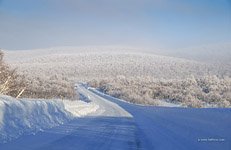 Kamchatka in winter #4
Kamchatka in winter #4
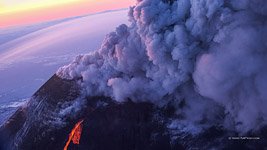 Volcano Klyuchevskaya Sopka #42
Volcano Klyuchevskaya Sopka #42
 Volcano Klyuchevskaya Sopka #36
Volcano Klyuchevskaya Sopka #36
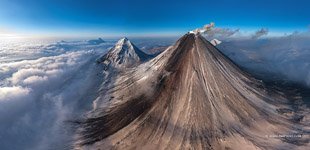 Volcano Klyuchevskaya Sopka #30
Volcano Klyuchevskaya Sopka #30
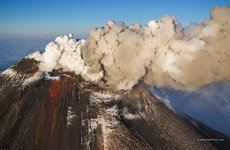 Volcano Klyuchevskaya Sopka #14
Volcano Klyuchevskaya Sopka #14
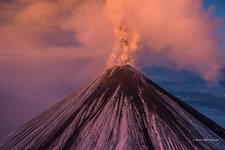 Volcano Klyuchevskaya Sopka #20
Volcano Klyuchevskaya Sopka #20
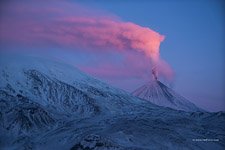 Volcano Klyuchevskaya Sopka #9
Volcano Klyuchevskaya Sopka #9
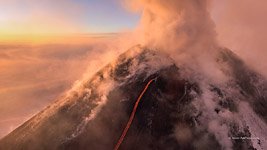 Volcano Klyuchevskaya Sopka #35
Volcano Klyuchevskaya Sopka #35
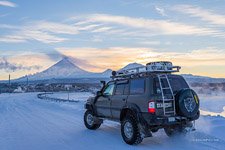 Kamchatka in winter #11
Kamchatka in winter #11
 Shooting of volcano eruption #4
Shooting of volcano eruption #4
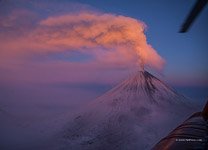 Volcano Klyuchevskaya Sopka #6
Volcano Klyuchevskaya Sopka #6

